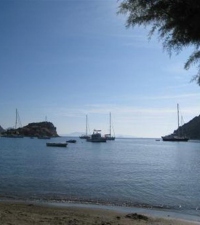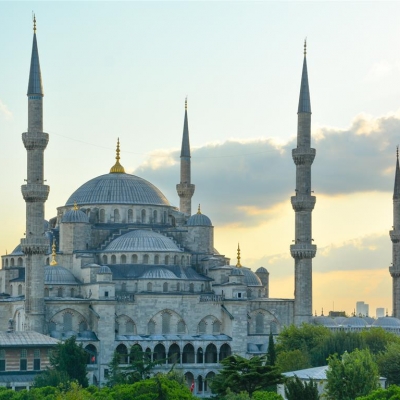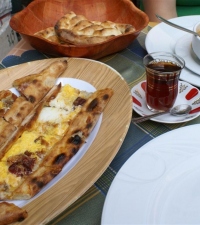Highlights of Turkey

Caria
Ancient Caria is a coastal region of Western Anatolia roughly corresponding to the modern Turkish province of Muğla. Today, the region has the largest concentration of expat retirees, mainly living in or around the Aegean resorts of Bodrum, Marmaris and Fethiye.
Bodrum
Bodrum is known as the St Tropez of Turkey. While this epitaph may not be entirely deserved, Bodrum is the place where the well-heeled come to get well-oiled. The pretty white-washed town is crammed with trendy bars, restaurants and shops with prices to match. In the heat of the day, people slowly amble along the promenade, gorge on gossip in the cafés, graze in the posh shops or relax under the cooling shade of a palm tree. By night, the prom sizzles to the heavy beat of Turkopop and a madding crowd of the weird, wonderful and well-to-do. Traditionally, Bodrum was where the unconventional sought refuge and where political dissidents were exiled. The liberal vibe continues to this day – there is Turkey and then there is Bodrum. To drive the point home, take a tour of the Zeki Müren Museum. This was where the extraordinary entertainer once lived, a man whose prodigious talent had Turks emptying shelves of his music, flocking to his films and weeping at his poetry. This was also the man who single-handedly advanced the cause of diversity in Turkey, even though he never actually stepped out of the closet. He didn’t need to. Festooned in gaudy jewellery and layered in silky foundation, he showed that difference was okay and the Turks loved him for it. The museum is a shrine to his camp and kitsch as much as it is to his career.
The Castle of St Peter, Bodrum’s Crusader heirloom is the jewel in the Town’s crown. Its sturdy silhouette dominates from every direction. Built by the Knights Hospitaller from 1402, the castle remained in Christian hands until they were unceremoniously booted out by Suleiman the Magnificent in 1522. The magnanimous Sultan allowed the defeated knights to sail off to Crete (clearly no hard feelings). The castle last saw action when it was bombarded by a French warship during the Great War. Presumably, they did it for fun as the fortress had long lost its strategic importance by then. Still, several towers were badly damaged and the minaret of the mosque (a former church) was toppled. Today, the reconstructed castle is a major tourist draw and home to the Museum of Underwater Archaeology, the biggest of its kind. The grounds also play host to the annual summer ballet and dance festival. It can be a sweaty affair during the height of the season, but rambling over the ramparts is a diverting excursion and there are plenty of shady places in the well-tended gardens to catch your breath and watch the randy dandy peacocks strut their stuff. The exhibits are absorbing if you’re into old wrecks, chipped anfora and ancient glass and sauntering through the various towers is a fun way to spend a spare afternoon. The English Tower, in particular, looks like a set from Ivanhoe. Where’s Elizabeth Taylor when you need her?
If you have an hour to spare, take a look around the meagre ruins of the once magnificent Mausoleum of Halicarnassus (Bodrum that was). The vast tomb was constructed to inter the remains of King Mausolus in 350 BC (hence the origin of the word mausoleum). The building was one of Wonders of the Ancient World, one of two in Anatolia (the other being the Temple of Artemis at Ephesus). Remarkably, the monument survived virtually intact for seventeen centuries before it was felled by an earthquake in the middle ages. What remained was plundered by the Knights of St John to build their castle. The present-day fortress rises above the same strategic promontory where Mausolus’ palace once stood. Admittedly, visitors need a vivid imagination to visualise the monument’s former splendour. All that remains is a large hole in the ground with multiple fragments of pillars and dressed stones scattered about randomly. There is a bijou and rather tired museum which attempts to fill in some of the detail. It features a naff video on a loop: more of a tourist board advert for Bodrum. Typically, there is more to see at the British Museum in London, but the ambience of the site is well worth experiencing.
Didyma
Surrounded by Didim, an ugly and unfinished urban sprawl, the superb temple and oracle dedicated to Apollo is fenced in by a shanty town crammed with scruffy establishments. Despite this encroachment, the vandalism of Christian fanaticism, earthquakes and frequent plunder, the vast shrine is an impressive pile and particularly beautiful in the late afternoon as the sun dips behind the huge pillars and dressed masonry.
Gümüslük
Gümüslük Bay is a beguiling little harbour village set among the meagre ruins of ancient Myndos on the northwest coast of the Bodrum Peninsula. As a protected archaeological site, the immediate vicinity has been saved from the relentless march of little white boxes up hill and down dale that afflicts much of the area. There’s very little to see of the ancient ruins themselves but recent excavations are beginning to reveal more. The village is famous for its identikit fish restaurants that line the bay. Beware, prices are high and the hassle is relentless. This is more than compensated for by the gorgeous sunsets on sultry summer evenings.
Sandima
Spring in Turkey is always a magical time of the year, nature-wise. The hills blossom overnight with all manner of flamboyant and exotic flora blanketing the usually arid scrub. It is a brief respite before the unforgiving sun burns the landscape back to its usual two-tone hue of dull green and ochre. Take advantage of the display while it lasts by strolling up to the old köy (village) of Sandima set in the foothills above the modern resort of Yalıkavak. The village is derelict save for a pretty house renovated by a local artist and a couple of centenarians. Sandima was abandoned when the villagers exchanged subsistence farming for the more lucrative trade of sponge diving. Yalıkavak was born and Sandima was left to decay into peaceful overgrown oblivion. Nowadays, most sponge gathering has stopped and the local economy is dependent on tourism (and the steady supply of gullible girls for the local gigolos). All of this has left Sandima as a fascinating and atmospheric ghost town with striking views and a rare feel. Go see.
Ionia
Ancient Ionia is a coastal region of Western Anatolia roughly centred round modern day Izmir, turkey’s third city. The area is also home to the sprawling bargain-bucket resort of Kuşadası, popular with British tourists looking for a little cheap fun in the sun with chips on the side and cruise liners despatching day-tripping elders.
Izmir
Izmir is Turkey’s third largest and most Western-leaning city with a population of about 2.8 million. No one would describe Izmir as beautiful. Much of it was burned to the ground in 1922 during the vicious and bloody Greco-Turkish War, and the city was unsympathically rebuilt with block upon block of mediocre concrete box architecture that surely wouldn’t withstand even the slightest tremor. However, the city does have a certain charm and the district of Alsancak, in particular, has a real buzz, all trendy shops and pavement cafés.
Ephesus
There are more ancient Greek sites in Turkey than there are in Greece or anywhere else in the ancient Greek world. None are more impressive than Ephesus: world heritage site nominee and arguably one of the most impressive open air museums to be found anywhere. Ephesus was one of the largest and most sophisticated cities of antiquity, adorned with grand civic buildings, marble-clad pavements and street lighting. It is estimated that by the first century BC, the city had a population of 250,000. Ephesus was partially toppled by an earthquake in 614 AD and its commercial importance withered as the harbour silted up. From then on, the city suffered sacking and conquest, and endured a long, lingering death before being completely abandoned in the 15th century. Today, what was the harbour is now 5 kilometres inland.
Ephesus is home to the Temple of Artemis, completed in 550 BC and one of the Seven Wonders of the Ancient World. 900 years later a Christian mob torched the building. Sadly, just one lonely, forlorn re-assembled pillar remains of Artemis' once vast shrine, rising up precariously from a mosquito-infested bog. The rest of the city is a magnificent affair and in impressively good shape after decades of excavation and partial reconstruction. The city was substantially remodelled by the Emperor Constantine and most of what you will see is from the late Roman period. The site has ‘monumental' carved into every stone, from the partially reconstructed Celcus Library to the 25,000 seater theatre, and much more besides. For a slice of domestic life, take a walk through the terraced houses with their courtyards, mosaics and frescos. A more utilitarian treat is the public latrines. The Romans were particularly fond of communal toileting, artfully combining conversation with evacuation. This glimpse into the ordinary is a fascinating combination of the mundane and the sublime. The city was of immense significance to the early Christian Church. St Paul wrote Epistles to the Ephesians. It can be reasonably argued that Christianity, as an organised religion, was founded in Ephesus. A word of caution, as Turkey's second most visited attraction after Sultanahmet (the Old City of Istanbul), Ephesus is best avoided at the height of summer when the unforgiving sun, lack of shade and rag-tag hordes of camera-toting tourists conspire to make the place Hell on Earth.
The Virgin Mary’s House
High in the verdant Italianate mountain-scape above Ephesus is the Virgin Mary’s House (Meryemana – Mother Mary in Turkish). Completed in 1950 in neo-Byzantine style on 7th century foundations, the house is a cute, unassuming little bungalow, now a consecrated church but with the character of a shrine. It’s the centre piece of well-tended park overlooking a pretty wooded valley. There is scant biblical evidence that the Virgin Mary found her last resting place here. Nevertheless, this hasn’t stopped the site becoming a side show on the bible tours circuit. Naturally, there's the standard tacky gift shop selling Chinese-made plaster figurines and vials of holy water.
Şirence
Close to the Virgin Mary’s House is Şirence, a small village clinging precariously to the hillside and surrounded by vineyards and orchards. Şirence had been a Greek populated settlement until 1923. During the exchange of populations between Greece and Turkey the inhabitants were told to pack their bags and leave for Athens. After being left to rot for decades, the village has re-emerged as a bolt hole for wealthy Turks attracted by the fine wood-framed stucco houses, many of which have converted into charming boutique hotels. Despite teeming hawkers serving the mob of tourists, both Turkish and foreign, the village retains a real appeal.
Priene
Just a few short kilometres south of Ephesus is Priene. Built on a natural escarpment high above the Meander River flood plain, Priene is the most complete Hellenistic site in all of Anatolia. Whereas Ephesus overawes with its colossal scale, Priene seduces with its intimacy and superb aspect. Stay a while and watch the sun set over the Ege, bathing the ruins in soft warm light.
Gulet Cruises
A gulet is a traditional two-masted wooden sailing vessel from the south-west coast of Turkey. Today, gulets are popular for tourist charters. Most are now diesel-powered and few are properly rigged for sailing. The word gulet is a loan-word from the old French gouëlette meaning “schooner”. If your vision of Hell is being squeezed onto a commercial party boat like the metro during the rush hour with a bunch of orange-faced holidaying strangers and brats in baseball caps then you should select your trip with care. The best advice is to get your own group together, find a smaller craft, talk to the captain about what floats your boat and off you go. Take a leisurely cruise around isolated coves and drop anchor at various brushy islets for a dip in the gorgeous translucent waters of the warm Aegean. Your cheery skipper will provide a simple but delicious lunch of fresh fish, meat balls or chicken accompanied by mezes, pasta and salad washed down with chilled and cheerful Anatolian plonk. End the voyage lazing away the afternoon basking on the deck. It’s a relaxing way to get away from the madding crowd.
Lycia
Ancient Lycia is a mountainous coastal region of south-western Anatolia, often described as the Turkish Riviera or the Turquoise Coast. The epitaph is justly applied as it is one of the most unspoilt areas of tourist Turkey, featuring sparking blue-green waters, long sandy beaches, high cliffs littered with rock tombs and hills smothered in pine forests. The small resort of Kaş sits at its heart and is a great base to explore the embarrassment of riches that are liberally scattered across the countryside. Hire a car and explore the must-sees.
Kaş and Kalkan
Kaş is a sparkling Bohemian jewel, surrounded by a pristine hinterland that has been mercifully spared the worst excesses of mass development due to the wilting two hour drive from the nearest international airport. The town has a laid-back, laissez-faire vibe with a good selection of restaurants and hotels to suite every budget and taste. Kaş’ twee smaller sister, Kalkan, is a few miles west along the hairpin coastal road and appeals to an older, wealthier crowd.
Patara
Patara is home to two unique attractions – a stunning 18 kilometre secluded stretch of soft white sand and the ruins of ancient Patara, once the main seaport of ancient Lycia. Meander through the sprawling ruins which, until recently, were partially covered by dunes, then bathe in the shallow waters of the bay. A word of warning, the beach is used by sea turtles to lay their eggs. As a protected site, little development is permitted and there’s next to no shade. It’s best avoided in middle of the day when the sun is at its strongest.
Letoon and Xanthos
Taken together, the cult sanctuary of Letoon and the city of Xanthos, the former capital of Lycia, constitute a UNESCO World Heritage site. The delicate and partially reconstructed ruins of Letoon, once dedicated to the Goddess Leto and her twins, Artemis and Apollo, are hidden inconspicuously among some fields. Nearby, Xanthos awes with its scale and picture postcard aspect. Back in the day, the plucky menfolk slaughtered their women, children and slaves rather than submit to the overwhelming might of Persia. Little good did it do them. One of the finest examples of Xanthan civic architecture – the Nereid Monument – can be seen in the British Museum. It was dismantled stone by stone and shipped off to London in the nineteenth century. All that remains is the base with a plaque inscribed with “…in the British Museum”. The city has been abandoned for centuries.
Arycanda
Built on five terraces high above a fertile plain, Arycanda was a leading city of ancient Lycia. The ruins are impressive and largely intact as the abandoned city’s high isolation prevented the dressed stones from being plundered in later periods. Unlike more famous sites like Ephesus, Arycanda isn’t overrun by coach tours so the chances are you’ll have it all to yourself. The city’s position, perilously perched on the side of a lush mountain provides a spectacular vista and a happy snapper’s delight.
Olympos
The tumbledown and overgrown city of Olympos is located in a valley leading to a broad shingle beach near the present-day village of Çıralı and is the centre-piece of the Olympos Coastal National Park. The area is a back-packer’s paradise and popular for trekking and adventure sports. The eternal flame called the Chimera, is located above Çıralı. The unusual geological phenomenon fires from cracks in the rock, fuelled by methane. Even if deliberately extinguished, the flame will spontaneously re-ignite. It was the stuff of legends for the ancients. The mythical Chimera was thought to be a monster with the head of a lion, the body of a goat and the tail of a serpent, roaming the woods spewing fire from its mouth. Ancients Lycians had vivid imaginations.
Saklikent Gorge
This 18 kilometre gorge is hundreds of feet deep, transports vast quantities of crystal-clear snow melt from the Taurus Mountains every year and is virtually invisible until you get inside. Traverse the wooden walkways to get to the mouth of the gorge, wade knee-deep through freezing open waters and ascend the four kilometres that are walkable. Wear sensible shoes you don’t mind getting wet, be prepared for bruises as you will slip and don’t visit before April or you’ll likely drown. After your healthy exertion, take tea at your leisure in the ramshackle carpeted cafés that line the entrance.
Phaselis
If you’ve not been totally ruined out, take a trip to pretty Phaselis, yet another Lycian city. A 24-metre-wide ancient street runs through the middle of town lined with Roman-period ruins. Phaselis is a city of three pretty harbours, a perfect place for a dip in the warm waters and a picnic under the shade of a pine tree.
The Lycian Way
If trekking gets the blood racing then take a stroll along the Lycian Way, Turkey’s first long-distance walk. The stunning 500 kilometre coastal trail has featured in ‘Time’ magazine and was selected by the BBC as one of the world’s 30 best walks. The route was laid out nearly 14 years ago, and snakes over the steep coastal cliffs, dips to isolated beaches and meanders through pine forests. It’s a hiker’s dream.
Pamphylia
Ancient Pamphylia is a region on the Mediterranean shores of south-western Anatolia roughly corresponding to the eastern half of the modern-day Turkish province of Antalya. The coastal region consists of a broad plain in the shadow of the snow-topped Taurus Mountains and is sprinkled with some of the best beaches in the Med. In recent decades, the area has developed into Turkey’s most popular tourist destination and attracts about 30% of all visitors to the country. The resulting riband development isn’t always aesthetically pleasing.
Antalya (ancient Attalia)
Antalya is Turkey’s fastest growing city with a population around the million mark, and is one of the country’s largest ports. The city was first founded in 150BC but these days, interest is generally confined to the impressive archaeological museum and the walled old town (Kaleiçi) where the pretty Ottoman-era buildings have been restored and converted into hotels, pensions, shops and restaurants. The old town makes an ideal base for exploring the ancient cities that are within an easy commute. Antalya has a vibrant nightlife which is concentrated around the harbour with a myriad of bars and clubs that pound out the beat until the small hours.
Perge and Aspendos
The extensive ruins of Perge are only about 15 kilometres east of Antalya. The former capital of Pamphylia was famed for being one of the richest and most beautiful cities of the ancient Greek world. The most striking feature of the city today is the Hellenistic Gate with its two enormous circular towers that lead to a 300 metre colonnaded street flanked by tumbledown shops. Apart from the gate, most of the ruins date from the Roman period. Aspendos (40 kilometres east of Antalya), is less impressive save for the splendid Roman amphitheatre, the best preserved in Turkey. Every summer, world-class operas and ballets are performed in the packed 10,000 capacity arena. The festival is organised by the State Opera and Ballet Directorate and attracts performers and audiences from all four corners of the globe. Kill to get a ticket. Take a packed supper and a cushion to sit on. Apart from the theatre, the remainder of the overgrown site has little to commend it when compared to Perge.
Coastal Resorts
The Antalya region of Turkey is popular with Germans and Russians who make up the bulk of the package tour visitors. Most resorts along the coast are nondescript concrete enclaves like Kemer except for high rise Alanya and antique Side. Sprawling Alanya, with its ribbon of all-inclusive hotels and resorts, does have the distinction of possessing wide, sandy beaches and a substantial hilltop castle with spectacular views. Side, one-time trysting place for Antony and Cleopatra, is unique in that the modern beach resort has grown around the classical ruins of the ancient city. The combination of earthquakes, Christian zealots and Arab raids, left the site abandoned by the 10th century, its citizens having migrated to nearby Antalya. The town was resettled by Muslim Turks from Crete at the end of the Nineteenth Century. The ruins may be impressive but the hassle from the resort’s hawkers is relentless.
By Jack Scott, author of Perking the Pansies, Jack and Liam move to Turkey, a bitter-sweet tragi-comedy recalling the first year of a gay couple in a Muslim land.
- My Life Abroad -
A selection of expat stories

"A fun compulsive read!"
J. Matcham, Amazon
"I strongly advise people ready to live abroad to read this book!"
Patrice, Amazon

 Highlights of Istanbul
Highlights of Istanbul Highlights of Turkey: Street Food
Highlights of Turkey: Street Food Driving: Life in the fast lane
Driving: Life in the fast lane